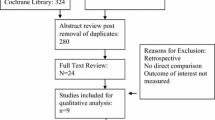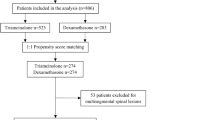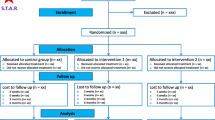Abstract
Purpose
We set out to compare outcomes in CT-guided lumbar transforaminal nerve root block patients receiving either particulate or non-particulate corticosteroids.
Materials and methods
This was a retrospective comparative effectiveness outcomes study on two cohorts of lumbar radiculopathy patients. 321 received particulate and 173 non-particulate corticosteroids at CT-guided transforaminal lumbar nerve root injections. The particulate steroid was used from October 2009 until May 2014 and the non-particulate steroid was used from May 2014. Pain levels were collected at baseline using an 11-point numerical rating scale (NRS) and at 1 day, 1 week and 1 month. Overall ‘improvement’ was assessed using the Patients’ Global Impression of Change (PGIC) at these same time points (primary outcome). The proportions of patients ‘improved’ were compared between the two groups using the Chi-square test. The NRS change scores were compared using the unpaired t-test.
Results
A significantly higher proportion of patients treated with particulate steroids were improved at 1 week (43.2 % vs. 27.7 %, p = 0.001) and at 1 month (44.3 % vs. 33.1 %, p = 0.019). Patients receiving particulate steroids also had significantly higher NRS change scores at 1 week (p = 0.02) and 1 month (p = 0.007).
Conclusion
Particulate corticosteroids have significantly better outcomes than non-particulate corticosteroids.
Key Points
• Better pain relief is achieved with particulate steroids.
• Significantly more patients report overall ‘improvement’ with particulate steroids.
• Significantly more patients report ‘worsening’ at 1 week with non-particulate steroids.

Similar content being viewed by others
References
Dietrich TJ, Sutter R, Froehlich JM, Pfirrmann CW (2015) Particulate versus non-particulate steroids for lumbar transforaminal or interlaminar epidural steroid injections: an update. Skeletal Radiol 44:149–155
Bensler S, Sutter R, Pfirrmann CW, Peterson CK (2016) Is there a difference in treatment outcomes between epidural injections with particulate versus non-particulate steroids? Eur Radiol
Friedly JL, Comstock BA, Turner JA et al (2014) A randomized trial of epidural glucocorticoid injections for spinal stenosis. N Engl J Med 371:11–21
Manchikanti L, Benyamin RM (2015) Key safety considerations when administering epidural steroid injections. Pain Manag 5:261–272
Manchikanti L, Kaye AD, Manchikanti K, Boswell M, Pampati V, Hirsch J (2015) Efficacy of epidural injections in the treatment of lumbar central spinal stenosis: a systematic review. Anesth Pain Med 5:e23139
Kenalog-10 F-USFaDAS, (triamcinolone taiaK-, injection. a. Available at: http://www.fda.gov/safety/medwatch/safetyinformation/ucm262876.htm. Accessed 2015 Feb 15
to FDSCFrlc, corticosteroid worbsnpae, pain. if. Available at: http://www.fda.gov/downloads/Drugs/DrugSafety/UCM394286.pdf. Accessed 2014 Aug 31.
Tinetti ME, Studenski SA (2011) Comparative effectiveness research and patients with multiple chronic conditions. N Engl J Med 364:2478–2481
Neumann PJ (2013) Communicating and promoting comparative-effectiveness research findings. N Engl J Med 369:209–211
Bensler S, Sutter R, Pfirrmann CW, Peterson CK (2015) Long Term Outcomes from CT-guided Indirect Cervical Nerve Root Blocks and their relationship to the MRI findings--A prospective Study. Eur Radiol 25:3405–3413
Fischer D, Stewart AL, Bloch DA, Lorig K, Laurent D, Holman H (1999) Capturing the patient's view of change as a clinical outcome measure. JAMA 282:1157–1162
McCormick Z, Kennedy DJ, Garvan C et al (2015) Comparison of Pain Score Reduction Using Triamcinolone vs. Betamethasone in Transforaminal Epidural Steroid Injections for Lumbosacral Radicular Pain. Am J Phys Med Rehabil 94:1058–1064
Choi JH, Hong JY, Suh SW et al (2016) What Is the Role of Epidural Steroid Injections in Lumbar Spinal Disease with Moderate Disability? Pain Physician 19:293–298
Kim D, Brown J (2011) Efficacy and safety of lumbar epidural dexamethasone versus methylprednisolone in the treatment of lumbar radiculopathy: a comparison of soluble versus particulate steroids. Clin J Pain 27:518–522
Park CH, Lee SH, Kim BI (2010) Comparison of the effectiveness of lumbar transforaminal epidural injection with particulate and nonparticulate corticosteroids in lumbar radiating pain. Pain Med 11:1654–1658
Kennedy DJ, Plastaras C, Casey E et al (2014) Comparative effectiveness of lumbar transforaminal epidural steroid injections with particulate versus nonparticulate corticosteroids for lumbar radicular pain due to intervertebral disc herniation: a prospective, randomized, double-blind trial. Pain Med 15:548–555
El-Yahchouchi C, Geske JR, Carter RE et al (2013) The noninferiority of the nonparticulate steroid dexamethasone vs the particulate steroids betamethasone and triamcinolone in lumbar transforaminal epidural steroid injections. Pain Med 14:1650–1657
McCormick ZL, Cushman D, Marshall B, et al (2016) Pain Reduction and Repeat Injections After Transforaminal Epidural Injection With Particulate Versus Nonparticulate Steroid for the Treatment of Chronic Painful Lumbosacral Radiculopathy. PM R
Denis I, Claveau G, Filiatrault M, Fugere F, Fortin L (2015) Randomized Double-Blind Controlled Trial Comparing the Effectiveness of Lumbar Transforaminal Epidural Injections of Particulate and Nonparticulate Corticosteroids for Lumbosacral Radicular Pain. Pain Med 16:1697–1708
Manchikanti L, Candido KD, Singh V et al (2014) Epidural steroid warning controversy still dogging FDA. Pain Physician 17:E451–E474
Rozin L, Rozin R, Koehler SA et al (2003) Death during transforaminal epidural steroid nerve root block (C7) due to perforation of the left vertebral artery. Am J Forensic Med Pathol 24:351–355
Bose B (2005) Quadriparesis following cervical epidural steroid injections: case report and review of the literature. Spine J 5:558–563
Meyer HJ, Monticelli F, Kiesslich J (2005) Fatal embolism of the anterior spinal artery after local cervical analgetic infiltration. Forensic Sci Int 149:115–119
Ziai WC, Ardelt AA, Llinas RH (2006) Brainstem stroke following uncomplicated cervical epidural steroid injection. Arch Neurol 63:1643–1646
Scanlon GC, Moeller-Bertram T, Romanowsky SM, Wallace MS (2007) Cervical transforaminal epidural steroid injections: more dangerous than we think? Spine (Phila Pa 1976) 32:1249–1256
Hodler J, Boos N, Schubert M (2013) Must we discontinue selective cervical nerve root blocks? Report of two cases and review of the literature. Eur Spine J 22:S466–S470
Houten JK, Errico TJ (2002) Paraplegia after lumbosacral nerve root block: report of three cases. Spine J 2:70–75
Wybier M, Gaudart S, Petrover D, Houdart E, Laredo JD (2010) Paraplegia complicating selective steroid injections of the lumbar spine. Report of five cases and review of the literature. Eur Radiol 20:181–189
Kennedy DJ, Dreyfuss P, Aprill CN, Bogduk N (2009) Paraplegia following image-guided transforaminal lumbar spine epidural steroid injection: two case reports. Pain Med 10:1389–1394
Lyders EM, Morris PP (2009) A case of spinal cord infarction following lumbar transforaminal epidural steroid injection: MR imaging and angiographic findings. AJNR Am J Neuroradiol 30:1691–1693
Chang Chien GC, Candido KD, Knezevic NN (2012) Digital subtraction angiography does not reliably prevent paraplegia associated with lumbar transforaminal epidural steroid injection. Pain Physician 15:515–523
Makkar JK, Singh PM, Jain D, Goudra B (2016) Particulate vs Non-Particulate Steroids for Transforaminal Epidural Steroid Injections: Systematic Review and Meta-analysis of the Current Literature. Pain Physician 19:327–340
Thefenne L, Dubecq C, Zing E et al (2010) A rare case of paraplegia complicating a lumbar epidural infiltration. Ann Phys Rehabil Med 53:575–583
Lenoir T, Deloin X, Dauzac C, Rillardon L, Guigui P (2008) Paraplegia after interlaminar epidural steroid injection: a case report. Rev Chir Orthop Reparatrice Appar Mot 94:697–701
El-Yahchouchi CA, Plastaras CT, Maus TP et al (2016) Adverse Event Rates Associated with Transforaminal and Interlaminar Epidural Steroid Injections: A Multi-Institutional Study. Pain Med 17:239–249
Plastaras C, McCormick ZL, Garvan C et al (2015) Adverse events associated with fluoroscopically guided lumbosacral transforaminal epidural steroid injections. Spine J 15:2157–2165
Lechmann M, Rosskopf A, Ehrmann C, Sutter R, Pfirrmann CW, Peterson CK (2016) Relationship of specific MRI findings to treatment outcomes in patients receiving transforaminal epidural steroid injections. Skeletal Radiol 45:1677–1685
Funding
The authors state that this work has not received any funding.
Author information
Authors and Affiliations
Corresponding author
Ethics declarations
Guarantor
The scientific guarantor of this publication is Susanne Bensler.
Conflict of interest
The authors of this manuscript declare no relationships with any companies whose products or services may be related to the subject matter of the article.
Statistics and biometry
No complex statistical methods were necessary for this paper.
Informed consent
Written informed consent was obtained from all subjects (patients) in this study.
Ethical approval
Institutional review board approval was obtained.
Methodology
• retrospective
• diagnostic or prognostic study
• performed at one institution
Rights and permissions
About this article
Cite this article
Bensler, S., Sutter, R., Pfirrmann, C.W.A. et al. Particulate versus non-particulate corticosteroids for transforaminal nerve root blocks: Comparison of outcomes in 494 patients with lumbar radiculopathy. Eur Radiol 28, 946–952 (2018). https://doi.org/10.1007/s00330-017-5045-z
Received:
Revised:
Accepted:
Published:
Issue Date:
DOI: https://doi.org/10.1007/s00330-017-5045-z




